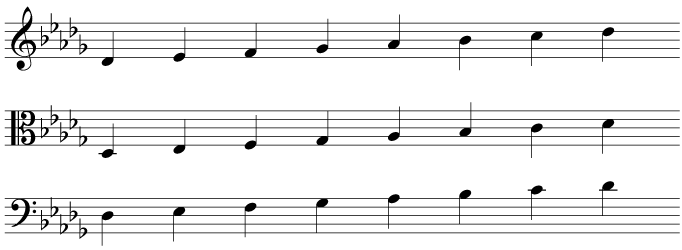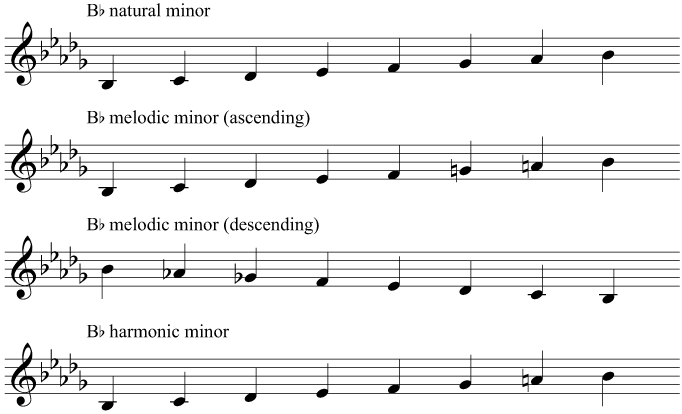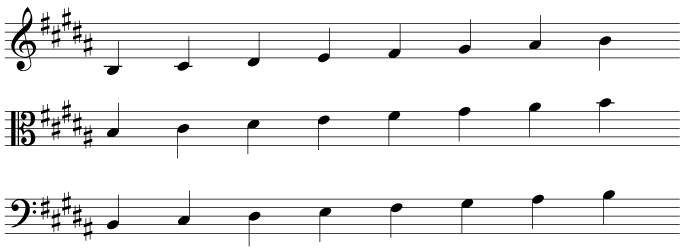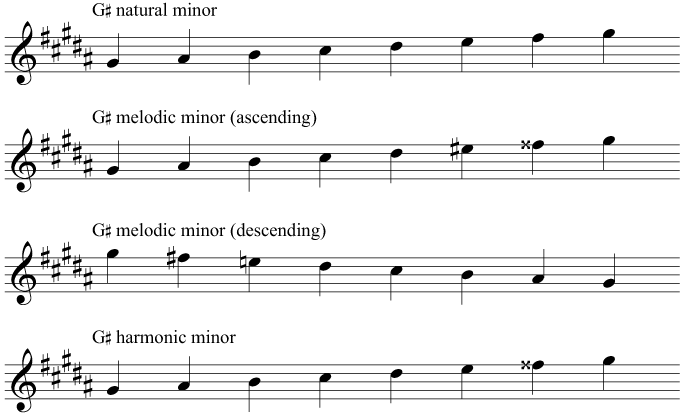Keys level 4
In this guide...
Key terms:
Subscription required!
To view the complete study guide, you will need a valid subscription. Why not subscribe now?
Already have a subscription? Make sure you login first!
Introduction
Introducing two new key signatures and the associated keys and scales, with five sharps and five flats - and a look at other key signatures in the alto clef.
The alto clef
You are probably becoming very familiar with key signatures of up to 4 sharps or flats, and we'll look at those with 5 flats and sharps here.
However, you will be soon be seeing more and more of the alto clef and it's worth reminding ourselves of the rules for the correct ordering of flats and sharps in the key signature with this in mind:
- Add new sharps (or flats) to the right of previous sharps (or flats)
(So in A major, we add the new sharp - G sharp - to the right of the two sharps from D major) - Put the sharp (or flat) in the highest available line (flats) or space (sharps), without going out of the stave
- The sharps (or flats) must rise and fall in sequence, unless doing so would cause the sharp/flat to go out of the stave
(So, if a sharp or flat is above the one before, the next sharp must go below)
If you do not play an instrument that uses the alto clef, you will not quickly become familiar with the correct notation of key signatures in that clef. So, it's worth being sure of the rules, as that is easier than memorising every single key signature!
If you are not yet familiar with the alto clef, it will be worth reading The C clefs first.
The alto clef key signatures
Let's look at the eight key signatures with which you will already be familiar - but in the alto clef, which is probably quite new to you.
The sharps
 Alto clef key signatures from 1 to 4 sharps
Alto clef key signatures from 1 to 4 sharpsThe flats
 Alto clef key signatures from 1 to 4 flats
Alto clef key signatures from 1 to 4 flatsC major / A minor are omitted from these examples, as of course they have no sharps or flats at all.
D flat major
Let's begin our look at some new keys with five flats: D flat major. Compare the key in each clef:
 The key signature and scale of D flat major in treble, alto, and bass clefs
The key signature and scale of D flat major in treble, alto, and bass clefsB flat minor
The relative minor of D flat major is B flat minor. Here it is in the treble clef:
 The key signature and scales of B flat minor
The key signature and scales of B flat minorB major
With five sharps in the key signature is B major. Again, compare the key signatures and the placement of the sharps in each clef:
 The key signature and scale of B major in treble, alto, and bass clefs
The key signature and scale of B major in treble, alto, and bass clefsIn this key signature, in the treble clef, the sharp indicating A sharp appears "down" again after the previous sharp was also "down". This appears to break the third rule given above, but if the sharp went "up", this would require a ledger line as it would be outside the stave.
We never use ledger lines in key signatures, and so the only possibility is to use the lower "A" space.
An exception
Now, the interesting question is why the bass clef and the alto clef also have the A sharp "down" when they could easily obey the third rule?
The answer is that this is an exception.
The reason is that, for piano music written in the grand staff, it would be confusing to a player trying to read quickly if the key signature in the treble and bass clef appeared to have different "shapes", and so the convention is for the bass clef to follow the same up/down pattern as the treble clef.
The alto clef also follows this pattern.
You might think that it would make life harder for you to have to remember this exception to the rules. However, it makes it easier!
You only have to remember the pattern for the treble clef. The alto and bass clefs follow the up/down pattern of the treble clef! And because the treble clef pattern is logical and follows the rules, you only have to remember the rules, and not the specific exceptions.
G sharp minor
Double sharps
None of the keys above should pose any problems for you.
On the other hand, G sharp minor, which we discuss below, might seem very strange, because it uses a double sharp.
If you are not yet familiar with double sharps, it is worth first reading Double sharps and flats.
Finally for this guide, we'll look at G sharp minor. The relative major of G sharp minor is B major. Here are the scales in the treble clef:
 The key signature and scales of B flat minor
The key signature and scales of B flat minorAs you can see, it is necessary to use an F double sharp for the raised 7th degree in the melodic ascending and harmonic minor scales.
In the natural minor scale, there is already an F sharp, and it must be raised by a semitone, requiring the use of a rare double sharp. Remember that the 7th degree cannot be a G natural (even though F double sharp is played and sounds the same as G natural), because the 7th degree must be a "type of" F, and we already have a "type of" G in the 1st degree (i.e., G sharp).
Double sharps are very rare in music, and most of the time you will only come across F double sharp. Occasionally you might also see C double sharp - and we'll look at one such situation in Keys level 5.
Read more...
With a subscription to Clements Theory you'll be able to read this and dozens of other study guides, along with thousands of practice questions and more! Why not subscribe now?
Revision
Are you sure you've understood everything in this study guide? Why not try the following practice questions, just to be sure!